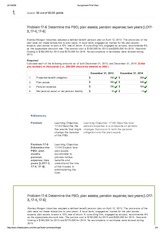
Generally, sole proprietors, partners, and LLC owner/members take owner draws as their payment. These draws can come on a schedule or be dependent on whether the business can handle losing more equity to the owner. S-Corp draws are distributions of profits to the shareholders of an S-Corporation. Unlike traditional C-Corporations, S-Corporations are pass-through entities, meaning they do not pay federal or state income tax on their earnings. Instead, the profits are allocated to the shareholders, who report them on their income tax returns.
Since partnerships are similar to sole proprietorships, partners can also receive an owner’s draw based on each partner’s share in capital and business profits. The owner’s draw method is often used for payment versus getting a salary. It offers greater flexibility for compensation because it can be regular or one-off payments.
No taxes are withheld from the check since an owner’s draw is considered a removal of profits and not personal income. All S corporation owners must take salaries, as they are considered management employees. When a business is profitable, an S corporation owner can earn dividend distributions. Keep reading to determine if owner’s draws are the best fit for your business. Many legal factors go into choosing whether to take an owner’s draw or a salary.
When you pay yourself a salary, you decide on a set wage for yourself and pay yourself a fixed amount every time you run payroll. Always remember, with a pass through entity you are taxed on the profit of the business regardless of how much money you leave in or take out of the business. If there are any co-owners, you should run any draws by all those involved. Hiding draws can lead to distrust among owners and a reduced cash flow. Your business has plenty of clients and your overall income for the last year was $120,000. You then discuss how much equity you now own in the business with your attorney.
How to protect your small business from inflation
Furthermore, it is important to note that the owner’s draw is not taxed when it is taken out of business. However, you need to pay taxes on such draws while filing personal tax returns. Whether you operate as a sole proprietorship, a partnership, or a corporation, rewarding yourself financially for all the hard work you do is paramount. So, how does a business owner get paid legally and what is the salary of a business owner? Keep reading to find the best answers to this question and protect yourself from bad financial decisions. For each personal draw, you receive throughout the year, record it in an owner’s draw account.
- C corps are taxed at a higher rate than individuals but have more benefits.
- Also, as a business owner, you pay taxes from the owner’s draw as in the case of a sole proprietor or partner.
- The members of LLC receive distributions from the company’s earnings.
- If you draw excessive amounts, the IRS may consider your business an unprofitable hobby and not allow for standard business deductions, which can cost you.
- In a partnership, each partner is personally taxed on half of the business profits.
- Keep in mind, however, that taking too much from the business can cause cash flow problems in the future.
Develop a smart strategy and use top-notch budgeting planners for taking money out of your company. Too many times, business owners take too much cash out of their business. For an S Corporation, total distributions are reported on Form 1120-S, page 5 Schedule M-2, line Owners draw vs salary 7. All owners will be issued a Schedule K-1 at the end of the year detailing their share of activity from the S Corporation, including distributions on line 19. If an owner has basis to receive a tax-free distribution it is added to net income on their tax return.
See Why 730,000+ Businesses Use Paychex
Every business owner needs to bring home a paycheck, but it can be difficult to understand your options and choose the best approach–especially if you are a new business owner. Figuring out how to pay yourself as a small business owner is one thing. There’s no one formula as businesses vary in industry, size and structure. When running a business, owners tend to pour their heart and soul into making sure the company stays afloat. Unfortunately, passion doesn’t pay the bills, and you cannot afford to work for free.
How to Utilize an Owner’s Draw for Tax Savings & Capital Growth
If distributions are made in excess of basis, or when there is a loss then the S Corp didn’t have enough basis to cover the loss. This means higher income and higher tax liability are passed through to the owners. Loss may be disallowed for an owner and carried forward to future years. Below, we’ll explain how to choose the best method for paying yourself as a business owner in a way that makes sense financially and practically for your specific situation. In the process, you can learn how to pay yourself with an owner’s draw or paycheck, how each method is taxed, and when to change your business entity status.
Make sure to keep a paper trail documenting your company’s performance and expenses so you can justify your wages if need be. Sole proprietors, partners, and owners of LLCs are free to pay themselves as they wish. If you’re not interested in the bonus route, you can always adjust your salary each year based on how your company is performing. Take a look back at the past year and give yourself a bonus that correlates to company growth after break-even.
How Much Should You Pay Yourself as a Business Owner?
As your circumstances change, you can always give yourself a raise or take a pay cut if needed. An LLC is also similar to a sole-proprietorship or partnership firm. Therefore, the owner of an LLC can receive the owner’s draw instead of a salary. Therefore, you can take an owner’s draw from the equity of your business. As mentioned above, an owner’s draw is the amount of money that you can take out from the owner’s equity for personal use. The funds drawn out of the business must be taken out of the business profits after paying all the business expenses.
At the end of the day, you will need to decide which distribution method is best for you based on your own situation and type of business. When choosing your own salary, be sure to choose an amount that keeps the business operational while also allowing you to enjoy your personal life outside of the business. The main con of taking an owner’s draw is that taxes are not automatically deducted. A salary works the same as it would at any other job—except you get to set your own wages and pay periods!
Where taxes come into play is at the end of the year when you’re filing your personal income tax. Any income you have earned in the year, whether that’s through your business, salary from another job, or a freelance gig, is considered taxable income. So if your business earned $200,000 and you took out $100,000 as your business owner’s equity, you’d pay income tax on that $100,000. Annie’s owner equity account would have a beginning balance of $60,000. If her business generates $40,000 in profits during the year, her owner’s equity account increases to $100,000.

Determining the appropriate split between the owner’s draw and salary can be complex for S-corp owners. When making this decision, owners should consider several factors, including industry standards, company revenue and profits, time and effort, and other compensation. Ensuring the total compensation is reasonable and reflects the owner’s contributions to the business is vital. S Corp owners due face additional administrative headaches and costs. This includes generating payroll and a W-2 for the business owners, along with additional filing fees for the S Corp. tax return. But if you plan on working in your business indefinitely and making reasonable profits, an S corporation might be your best bet.
How to prepare your small business for a recession
On the other hand, if your business has surplus cash flow, you may be able to take an owner’s draw without impacting your ability to pay bills and other expenses. $300 today, $600 tomorrow, $200 the next day — binge buying is addictive. Yes, the temptation to employ it and spend all that cash pouring in is pretty strong, particularly if you’re operating a service-based business and, thus, get paid on a daily basis.
The small business employee who often gets paid last and the least – CNBC
The small business employee who often gets paid last and the least.
Posted: Thu, 20 Oct 2022 07:00:00 GMT [source]
That aside, when you pay yourself too much, you’re also draining your business potential. We will tell you the business reasons for determining how to pay yourself. Just fill out the form below and we will set up a call to get to know you and your business. This means that you should be paying yourself similarly to other companies that are earning as much, are the same size, and in the same industry as your business.

However, corporation owners can use salaries and dividend distributions to pay themselves. An owner’s draw is when an owner of a sole proprietorship, partnership or limited liability company (LLC) takes money from their business for personal use. The money is used for personal expenses as opposed to taking a traditional salary.